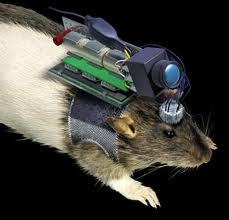A remotely-guided rat, popularly called a ratbot or robo-rat, is a rat with electrodes implanted in
A remotely-guided rat, popularly called a ratbot or robo-rat, is a rat with electrodes implanted in the medial forebrain bundle (MFB) and sensorimotor cortex of its brain. They were developed in 2002 by Sanjiv Talwar and John Chapin at the State University of New York Downstate Center. The rats wear a small electronics backpack containing a radio receiver and electrical stimulator. The rat receives remote stimulation in the sensorimotor cortex via its backpack that causes the rat to feel a sensation in its left or right whiskers, and stimulation in the MFB that is interpreted as a reward or pleasure.After a period of training and conditioning using MFB stimulation as a reward, the rats can be remotely directed to move left, right, and forward in response to whisker stimulation signals. It is possible to roughly guide the animal along an obstacle course, jumping small gaps and scaling obstacles.Currently, robo-rats are primarily being trained to detect explosives in areas where humans and existing robots cannot efficiently search, such as crowds and cargo ships. Other possible uses of the robo-rat include search and rescue operations following a natural disaster, military reconnaissance and landmine detection. A camera, transmitter, and GPS receiver that mount on rat backpacks have been designed to facilitate these purposes. However, it has been suggested that by interpreting biological signals directly from the brain of the rat, additional information could be obtained without the use of external equipment. This could be used, for example, to detect chemical and biological toxins in the air via the rat’s own sense of smell. -- source link
Tumblr Blog : horror-is-not-dead.tumblr.com
#robot#robot rat#scary#strange#science#natural#disaster#training#whiskers#robo rat#guided#guided rat#reward#transmitter#new york#downstate#center#animal#mouse#popular
